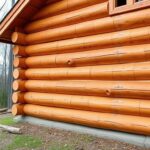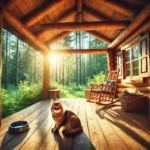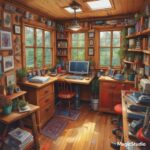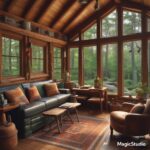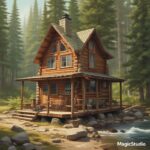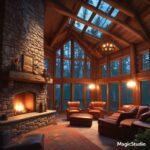Here Is The Introduction To “History of Log Cabins”
The log cabin is an iconic representation of the American frontier spirit of individualism and self-sufficiency, but it has a history far beyond the US. Although this style has drastically transformed from an ancient Nordic dwelling into a contemporary luxurious resort, log cabins have always been a core draw as sustainable, durable households. This detailed investigation outlines the unique evolution of log cabin architecture throughout history and probes the adaptation of log cabin form to different historical moments, all the while preserving the historical appeal of log cabin form.
Ancient Origins and European Roots
Log structures have been built since the Bronze Age, and the oldest identified log structures are located in Northern Europe, specifically in Scandinavia. Archaeological evidence suggests that by 3500 BCE, resident groups of the modern Swedish, Norwegian, and Finnish zones had mastered complex carpentry techniques for log houses. These early Norse builders developed the crucial cornerstone notching system, which allowed for sturdy construction without nails or other metal fasteners.
Medieval East Europeans, more particularly in Russia, Ukraine, and Belarus, also enhanced log construction technologies. They developed various corner joining methods, including the dovetail notch, which remains one of the strongest and most aesthetically pleasing ways to join logs. Forest coverage in these areas practically forced the use of logs as building material and the superior insulating capacity of the solid logs provided the inhabitants with a chance to live through extremely cold winters.
Migration to North America
The settlement of the North American continents by Europeans brought them into a forest wilderness and they soon learned to adapt their building methods to accommodate materials on site. Swedish settlers in New Sweden (now Delaware) erected the first log buildings in North America in around 1638. These structures were markedly different from the Native American structures the settlers encountered and it brought a new architectural paradigm to the land.
The next generation of Dutch and Scots-Irish immigrants that settled there brought their forms of log construction practice with them. They described V-notch and half-dovetail-join features and found them extra well adapted to the American plains. These techniques gradually flowed into the colonies and eventually, at last, evolved into the regular practice of building American log houses.
The American Frontier Era
Settlement and Expansion
In the westward expansion of the US in the 18th and 19th centuries, log cabins became a symbol of frontier life. The masonry technique worked well for the pioneer families it allowed, them to only use a few tools, and none of those were nails, which were both expensive and often unavailable on the frontier. A trained carpenter could build a simple cabin within a few weeks, offering much-needed shelter to individuals traveling west.
Presidential Connections
The log cabin achieved a special symbolic significance in American political myth by being linked to many presidents. Seven US presidents were born in log cabins, perhaps most famously Abraham Lincoln, whose origins as a humble log cabin baby were manufactured into a powerful symbol by the U.S. presidential campaign of 1860. Andrew Jackson, James Buchanan, and James Garfield, along with others, also originated from log cabin roots and, as a result, reinforced the symbolic nature of the structure as a wellspring of American leadership.
Architectural Evolution
Victorian Era Adaptations
In the late 19th century, however, the log cabin started to go through transformations, which extended beyond its basic functions. The Victorian period witnessed the development of more ornate log structures, featuring decorative features as well as contemporary functionality. Moneyed urbanites began building simple rustic log vacation cabins in the Adirondack Mountains generating what would be known as the “Camp” architecture. These qualities combined traditional log building with modern building types, creating a distinctly American built form.
The Arts and Crafts Movement
The Arts and Crafts movement of the early 20th century embraced log construction as an expression of natural building materials and honest craftsmanship. Architects such as Gustav Stickley used log construction promoted in his widely read “The Craftsman” magazine, raising the status of the log cabin from a simple dwelling to an accomplished architectural structure.
Modern Innovations and Contemporary Trends
Technological Advances
The construction of log cabins is characteristic of a revolution triggered by technological development. Computer-aided milling machines could now precisely and consistently mill logs with a highly branched arrangement of joints. These innovations have improved construction efficiency and structural performance while retaining the vernacular aesthetic of hand-squared logs.
Sustainability and Energy Efficiency
Today’s log cabins often incorporate cutting-edge sustainable building practices. Modern builders use techniques such as:
- Strategic window placement for passive solar heating
- Advanced chinking materials for better insulation
- Integrated solar power systems
- Rainwater harvesting systems
- Green roof technologies
Contemporary Design Trends
Modern log homes often blend traditional construction methods with contemporary architectural elements. Floor-through-the-wall windows, open floor plans, and modern features are many times incorporated in log home designs. Some innovative approaches include:
Cultural Impact and Preservation
Heritage Conservation
Organs are improving historic log structures in North America and Europe. These conservation activities provide substantial evidence of the construction practices of the past and the style of life of the ancestors. The National Park Service maintains several recognizable log structures that serve to teach a valuable architectural artifact to the public.
Educational Value
Historic log cabins are valuable teaching tools by providing direct connections to the past. Living history museums and reconstructions both offer potential to the visitor a realization of pioneer life and their past building practice. These websites have huge significance in conservation, and more importantly, in further research of traditional building knowledge and craft.
Regional Variations
Global Adaptations
Despite log cabin construction being a Northern European invention, different forms have developed elsewhere:
The regionalist nature of the Alps, with its large eaves and steep roofs for accommodating heavy snow loads, resulted in unique typologies. Russian masons carved complex decorative elements from inexpensive timber. Japanese carpenters applied the log construction technique to their traditional stylistic approach and created subtlely different hybrid styles.
| Region | Distinct characteristic features | Traditional application | Region Specific application |
|---|---|---|---|
| Alpine | Steep roof houses with limited overhangs | Pine, Spruce | Year-round dwellings |
| Alpine | Deep eaves and decorative balconies | Larch, Stone Pine | Cave shelters |
| North America | Many styles, practical forms | Oak, Pine, Cedar | Homesteading |
| Russia | Distinctive carpentry and aesthetic details | Siberian Pine | Permanent dwellings |
| Japan | Hybrid type with traditional forms | Cypress, Cedar | Mountain lodges |
Economic and Social Implications
Property Values and Investment
Used to be real estate, currently, usage logs homes today are generally sold at a high price, in particular in scenic places. The strength and specialness of log building can make it very valuable to resell. However, maintenance and insurance, costs can affect the total cost of ownership.
Community Impact
Log home villages have also served as a driving force for economic activity in the backcountry. Such developments are not uncommon and with positive implications for tourism, yet also contribute to the thewell-beingg of local handicraft industries. There is a consumption market for log homes which generates jobs in construction and in livelihood activities that are related to that.
Future Prospects
Emerging Trends
The outlook for log cabin construction is promising, with current trends:
- Integration of smart home technology
- Development of new preservation techniques
- Innovative hybrid construction methods
- Enhanced energy efficiency systems
- Prefabricated log home components
Conclusion
Starting aa s tiny first sheltering, and today progressing to a comfortable home and a getaway house, the log cabin has demonstrated itself to be an enduring model of adaptation over millennia. Their evolution is part of more general trends in society, technology, and architecture, but at the same time is also closely linked to ancient building techniques and cultural identity.
That the most enduring popularity of log cabins is due to their capacity to synthesize rustic sentiment with contemporary functionality, sustainability with hardiness, and historic value with current importance is a key explanation. In the future construction, log cabin building is still evolving in response to changing requirements and desires, but retains its basic/core form as a human creation with human imagination and ingenuity, as well as human skill embedded in it.
This architectural form, which began as a simple solution to the need for shelter, has become a sophisticated building system that continues to capture imaginations and provide comfortable, sustainable housing. The history of the log cabin is just starting, and new generations still innovate but keep traditional, those have made the log cabin buildings an architectural heritage of great relevance.


